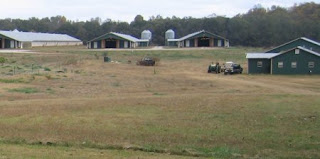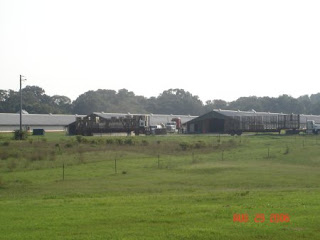
The first picture is looking down from our house towards the farm. You can see the shed/office on
the right side. That is a small office building attached to the shed where we keep our John Deere tractor and tractor accessories like mower, blower, spreader, trailer. All those things that end in -er. On the left you see three of the six chicken houses we have. They are 40 feet wide and 500 feet long. Each one holds about 22,000 chickens. In this picture the doors are open because it is between flocks and we are cleaning it out and getting it set up for the next flock.

In the second picture you see inside the chicken house after we have cleaned it out, had pine shavings spread on the floor, laid down paper under the feed bowls, and dropped down the feed bowls and outside drinker lines. This is my favorite time of the flock. The houses smell very nice with all the pine shavings on the floor, and it is nice and level, and no worry about stepping on a chicken. Currently we are between flocks, but are still in the process of having the litter removed. After that I blow all the dust and cobwebs out of the house with a high powered blower that runs off the power from the tractor. Next, I call the shavings people and they back a truck into the house and drive it out, spreading shavings pretty evenly all over the floor.

The next step is for the company to come and deliver the baby chicks to us. A large heated tuck comes filled with baskets of chicks. Each basket has 100 chicks in it. They take them off the truck and slide them onto our trailer. They put how ever many chicks will go into one house on the trailer and then we back the trailer into the house. Once in, the tractor driver, currently my dad, drives out of the house very slowly.

As he drives forward the two guys who drove the truck to the farm and myself dump the chickens out of the basket onto the floor. There are a lot of baskets to dump out, so the tractor never stops going forward towards the door, and we never stop dumping the chickens onto the floor as quickly as we can. If the tractor stops it would allow the chicks to run under the wheels, so we can't stop. The chicks are dropped right next to the food, and once the trailer is out of the house drinker lines are lowered. There are four lines of drinkers and two lines of food. Also notice that between the bowls are piles of food. For the first week the food gets dropped into the bowls and onto the floor twice a day. This allows all the birds to have access to food to get off to a good start. After the week is over the food only goes into the bowls to reduce waste. The chicks are big enough at that point to eat from the bowls.

In this picture the chicks have grown. They are about five weeks old here. I can tell that because they are almost through molting. They have changed color from the cute yellow baby chicks into the white feathers of the adult chicken. If you look closer you may be able to see some of them still have yellow heads, which tells me they are not quite there yet. Usually around six weeks the yellow is completely gone.

This picture shows the length of the house. At five weeks there is still plenty of room on the floor for them to move around. By the time they are eight and nine weeks old the floor is white from one end to the other and walking through the house is practically impossible, but still necessary. The bight light at the end of the house comes from large tunnel fans which suck the air through the house.

Finally, after about 63 days the chickens have grown to hopefully near an average of 8 pounds. I then get scheduled for a pick up. The company comes to the farm with two crews of workers, two fork lifts, and an unending flow of tractor trailers to carry the birds away. The crews go in and pick up the chickens by hand, placing them into cages which the fork lifts pick up when they are full and load onto the trailers. They work about four hours per house to empty about 21,000 chickens out. The crews typically do two houses and then are replaced by another crew. I believe a crew that goes into one house is about 8 people. So each guy in the crew picks up around 2,600 eight pound chickens and puts it in a cage. I would not want the job.
They take them away, weight them, and process them. After that they give me an estimate for how many days I have before they bring my new chicks, and I get back to work cleaning the houses out and setting them up again. So that is a tour of our farm.
5 comments:
Wow Ken, I'm impressed! I bet the kids love when the baby chicks arrive. I know I'd be excited. I'm also excited to watch your blog and get to know T and Q.
K--I'm curious. Have you ever considered growing cagefree chickens? Would the higher price they command be worth the effort? That's what my husband and I tend to buy/eat when we eat chicken.
Re the question I posted: Reading The Omnivore's Dilemma was fascinating and eye-opening for me in terms of talking about various ways of raising animals.
Oh my gosh.... every where a chick, chick. Good for you. I moved away from SD too to rural Colorado. It just seems to be too much hassle to run the rat race...
I'll be checking in to see how things are going!
[...] and may even be able to spend the four days it takes to mow the lawn. You may hear me say,”I love chicken farming.” at this time of the [...]
Post a Comment